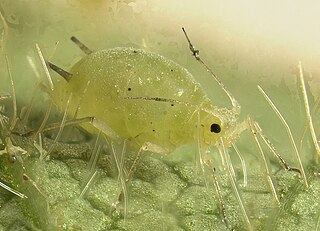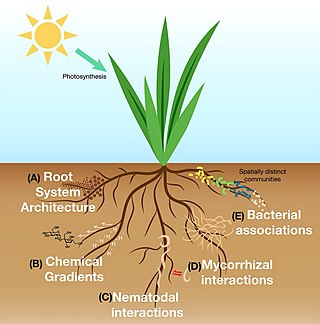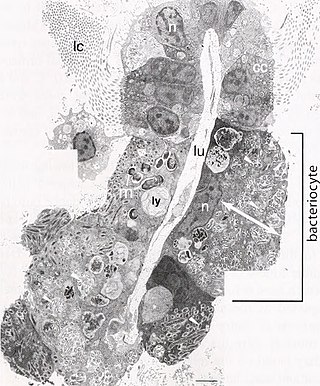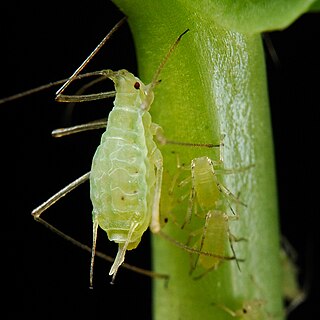
An endosymbiont or endobiont is an organism that lives within the body or cells of another organism. Typically the two organisms are in a mutualistic relationship. Examples are nitrogen-fixing bacteria, which live in the root nodules of legumes, single-cell algae inside reef-building corals, and bacterial endosymbionts that provide essential nutrients to insects.

Symbiosis is any type of a close and long-term biological interaction, between two organisms of different species. The two organisms, termed symbionts, can be either in a mutualistic, a commensalistic, or a parasitic relationship. In 1879, Heinrich Anton de Bary defined symbiosis as "the living together of unlike organisms".

Mutualism describes the ecological interaction between two or more species where each species has a net benefit. Mutualism is a common type of ecological interaction. Prominent examples are:

Pitcher plants are carnivorous plants known as pitfall traps—a prey-trapping mechanism featuring a deep cavity filled with digestive liquid. The traps of pitcher plant are considered to be "true" pitcher plants and are formed by specialized leaves. The plants attract and drown the prey with nectar.

Aphids are small sap-sucking insects and members of the superfamily Aphidoidea. Common names include greenfly and blackfly, although individuals within a species can vary widely in color. The group includes the fluffy white woolly aphids. A typical life cycle involves flightless females giving live birth to female nymphs—who may also be already pregnant, an adaptation scientists call telescoping generations—without the involvement of males. Maturing rapidly, females breed profusely so that the number of these insects multiplies quickly. Winged females may develop later in the season, allowing the insects to colonize new plants. In temperate regions, a phase of sexual reproduction occurs in the autumn, with the insects often overwintering as eggs.

The Aphididae are a very large insect family in the aphid superfamily (Aphidoidea), of the order Hemiptera. These insects suck the sap from plant leaves. Several thousand species are placed in this family, many of which are considered plant/crop pests. They are the family of insects containing most plant virus vectors with the green peach aphid being one of the most prevalent and indiscriminate carriers.

Myrmecophytes are plants that live in a mutualistic association with a colony of ants. There are over 100 different genera of myrmecophytes. These plants possess structural adaptations in the form of domatia where ants can shelter, and food bodies and extrafloral nectaries that provide ants with food. In exchange for these resources, ants aid the myrmecophyte in pollination, seed dispersal, gathering of essential nutrients, and defense. Domatia adapted specifically to ants may be called myrmecodomatia.

The rhizosphere is the narrow region of soil or substrate that is directly influenced by root secretions and associated soil microorganisms known as the root microbiome. Soil pores in the rhizosphere can contain many bacteria and other microorganisms that feed on sloughed-off plant cells, termed rhizodeposition, and the proteins and sugars released by roots, termed root exudates. This symbiosis leads to more complex interactions, influencing plant growth and competition for resources. Much of the nutrient cycling and disease suppression by antibiotics required by plants occurs immediately adjacent to roots due to root exudates and metabolic products of symbiotic and pathogenic communities of microorganisms. The rhizosphere also provides space to produce allelochemicals to control neighbours and relatives.

A bacteriocyte, also known as a mycetocyte, is a specialized adipocyte found primarily in certain insects such as aphids, tsetse flies, German cockroaches, weevils, and ants. These cells contain endosymbiotic organisms such as bacteria and fungi, which provide essential amino acids and other chemicals to their host. Bacteriocytes may aggregate into a specialized organ called the bacteriome.
Ecological facilitation or probiosis describes species interactions that benefit at least one of the participants and cause harm to neither. Facilitations can be categorized as mutualisms, in which both species benefit, or commensalisms, in which one species benefits and the other is unaffected. This article addresses both the mechanisms of facilitation and the increasing information available concerning the impacts of facilitation on community ecology.

Honeydew is a sugar-rich sticky liquid, secreted by aphids, some scale insects, and many other true bugs and some other insects as they feed on plant sap. When their mouthpart penetrates the phloem, the sugary, high-pressure liquid is forced out of the anus of the insects, allowing them to rapidly process the large volume of sap required to extract essential nutrients present at low concentrations. Honeydew is particularly common as a secretion in hemipteran insects and is often the basis for trophobiosis. Some caterpillars of Lycaenidae butterflies and some moths also produce honeydew. In addition to various sugars, honeydew contains small amounts of amino acids, other organic compounds, and inorganic salts with its precise makeup affected by factors such as insect species, host plant species, and whether a symbiotic organism is present.
Cheating is a term used in behavioral ecology and ethology to describe behavior whereby organisms receive a benefit at the cost of other organisms. Cheating is common in many mutualistic and altruistic relationships. A cheater is an individual who does not cooperate but can potentially gain the benefit from others cooperating. Cheaters are also those who selfishly use common resources to maximize their individual fitness at the expense of a group. Natural selection favors cheating, but there are mechanisms to regulate it. The stress gradient hypothesis states that facilitation, cooperation or mutualism should be more common in stressful environments, while cheating, competition or parasitism are common in benign environments.

Camponotus compressus is a type of ground-nesting species of ant found in India and Southeast Asia. It is a frequent visitor to toilets as it consumes urea. It is one of the many species which tends plant-sap-sucking insects like aphids and tree hoppers. They add nutrients into the soil through their discarded waste piles These ants stroke their antenna on the hind parts of these insects stimulating them to excrete a sugar rich liquid, called honeydew, which the ants consume. In return, they are known to protect the insects from predators like ladybugs. These ants range from red to black and some times appear slightly yellow in colour.

Myrmecophily consists of positive, mutualistic, interspecies associations between ants and a variety of other organisms, such as plants, other arthropods, and fungi. It may also include commensal or even parasitic interactions.

Insect ecology is the interaction of insects, individually or as a community, with the surrounding environment or ecosystem. This interaction is mostly mediated by the secretion and detection of chemicals (semiochemical) in the environment by insects. Semiochemicals are secreted by the organisms in the environment and they are detected by other organism such as insects. Semiochemicals used by organisms, including (insects) to interact with other organism either of the same species or different species can generally grouped into four. These are pheromone, synomones, allomone and kairomone. Pheromones are semiochemicals that facilitates interaction between organisms of same species. Synomones benefit both the producer and receiver, allomone is advantageous to only the producer whiles kairomones is beneficial to the receiver.

Fungivory or mycophagy is the process of organisms consuming fungi. Many different organisms have been recorded to gain their energy from consuming fungi, including birds, mammals, insects, plants, amoebas, gastropods, nematodes, bacteria and other fungi. Some of these, which only eat fungi, are called fungivores whereas others eat fungi as only part of their diet, being omnivores.
Trophic mutualism is a key type of ecological mutualism. Specifically, "trophic mutualism" refers to the transfer of energy and nutrients between two species. This is also sometimes known as resource-to-resource mutualism. Trophic mutualism often occurs between an autotroph and a heterotroph. Although there are many examples of trophic mutualisms, the heterotroph is generally a fungus or bacteria. This mutualism can be both obligate and opportunistic.

Acyrthosiphon pisum, commonly known as the pea aphid, is a sap-sucking insect in the family Aphididae. It feeds on several species of legumes worldwide, including forage crops, such as pea, clover, alfalfa, and broad bean, and ranks among the aphid species of major agronomical importance. The pea aphid is a model organism for biological study whose genome has been sequenced and annotated.

Tritrophic interactions in plant defense against herbivory describe the ecological impacts of three trophic levels on each other: the plant, the herbivore, and its natural enemies. They may also be called multitrophic interactions when further trophic levels, such as soil microbes, endophytes, or hyperparasitoids are considered. Tritrophic interactions join pollination and seed dispersal as vital biological functions which plants perform via cooperation with animals.

Niphanda fusca is a parasitic butterfly primarily found in East Asian countries such as Japan and Korea. It is a "cuckoo-type" parasite of the ant Camponotus japonicus. It utilizes chemical mimicry to trick the host worker ants into adopting it while it is a third-instar caterpillar. From there, it is fed mouth-to-mouth by the worker ants as though it were one of their own young.

















